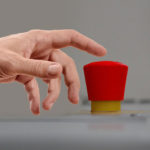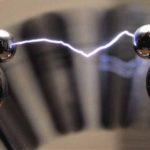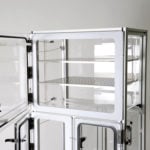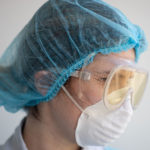This post covers the different types of static control ionization equipment and technologies. Which is best for your application? Corona ionization and alpha ionization are the two most popular methods.
What is Corona Ionization
Corona ionization is the most common ionization method in manufacturing environments. A 5K – 20K V charge to a single sharp-tip emitter creates and expels ions. The short range of roughly ~1mm requires a fan or compressed air for extended target distances. Blower fans extend the target range to roughly 24 – 36 inches.
Dust and debris flowing toward the emitter will eventually starve the ionization process unless regularly serviced. Routine balancing and cleaning maintain the equilibrium between positive and negative ions.
Ideal uses for Corona include:
- Most applications in semiconductor packaging and testing including, plastics, carding, converting, textiles
- Applications where temperature extremes are not required and there is adequate space to fit a blower into the process
Types of Corona Ionization
AC Ionizers
AC ionizers use a transformer to multiply the AC power line voltage. AC stands for “Alternating Current” which means that the power cycles from positive to negative sixty times per second.
An AC ionizer produces both positive and negative ions from the same points or emitters. The drawback of this approach is that many ions recombine because the cycle frequency is too fast. For this reason, most AC ionizers rely on fans or blowers to be effective.
Steady-state DC Ionizers
Steady-state DC ionizers also employ separate power supplies and emitters, but instead of alternating positive and negative, both supplies are on all the time as the name implies. As would be expected, there is some degree of recombination, however, the ion density is still greater because of the continuous operation of both supplies. The offset or balance voltage at the output will normally be more consistent than pulse units.
What is Alpha Ionization?
Alpha ionization uses Polonium-210, a naturally occurring radioisotope found in the soil, plants, vegetables, etc. Polonium-210 releases alpha energy which is exceptionally effective as an ion source to neutralize static charges.
The major advantage of alpha ionization for extremely sensitive ESD-sensitive components is that it always produces a balance of positive and negative ions. Because it does not require an external power source, the technology is preferred in explosive, harsh, flammable, or close-quarter environments.
Alpha particles ionize adjacent air and neutralize static electricity on nearby contact surfaces. Air molecules create pairs of positive and negative ions which move only with airflow, thus an external power source is not required.
Alpha ionization is not limited to a single point emitter, as it is with corona, so it is a very effective and predictable method of ionization. Static charges are neutralized right at the source, with the ionization process remaining in constant balance. That translates to improved results and cost efficiencies.
Alpha ionization offers outstanding performance in extreme conditions without requiring an electrical connection. Smaller chips and downsized components increase the demand for non-invasive, electrically independent static control devices. Nuclear static control devices thrive when space, electrical sensitivity, harsh conditions, and maintenance requirements would otherwise not favor AC/DC ionization equipment.
Uses for NRD ionization include:
- Applications with temperature extremes (-40°C to 180°C)
- Areas with tight confines, like a handler
- Applications involving Class 0, highly static-sensitive parts
- Nanotechnology, electronics manufacturing, and testing
While alpha ionizers require no maintenance or balancing like corona models, they do require replacement every 12-15 months and are subject to government regulations.
Read More: Is Alpha Ionization Safe?
Static Control Ionization Basics 101
Air ionization neutralizes static charge on insulated objects by producing a balanced source of positively and negatively charged ions. Because it uses only the air that is already present in the work environment, air ionization may be employed even in cleanrooms where chemical sprays (staticides) and some static dissipative materials are not usable. A flood of ionized air prevents airborne particle clumps, static cling, and static discharge between people, objects, and surfaces.
Common Applications Include:
- Rolling paper
- Manufacturing sheet plastics
- Spinning synthetic fibers
- Thin-film microelectronics
- Automated assembly lines
- OEM assembly servicers
Read more: Air Ionization – How Does it Work?
Static Control Principles and Charged Objects
Every object is constructed of atoms. Each atom contains a core of positively charged protons, neutral neutrons, and outer ‘shells’ of negatively charged electrons. A charged object contains an unequal number of protons and electrons.
Charge is a property of matter that produces electrostatic attraction or repulsion when placed in an electromagnetic field. Energized ions create ‘air ions’ which move freely in the air until encountering an ion of opposite charge or a grounded surface. An object surrounded by ions of positive and negative charges will attract ions opposite of its charge. Electrical ionizers balance these charges by flooding the air with ion pairs and thus neutralizing unbalanced charges.
ESD Sensitive Materials and Static Control Areas
Insulative materials such as rubber, plastic, glass, and other insulators tend to generate and hold surface charges. Ionization is one of the only practical methods of removing a static charge on insulative objects.
Necessary non-conductors (i.e. process-required insulators) in the environment cannot lose their electrostatic charge by attachment to the ground. Ionization systems provide neutralization of charge on these necessary non-conductive items (circuit board materials and some device packages are examples of necessary non-conductive items). Electro-static protected areas (EPAs) ensure a safe area and appropriate process controls when handling electrostatically sensitive (ESDS) items. See the full list of ESDS Items.
Most static control ionizers generate air ions by a process known as either corona discharge or alpha particle generation.
Types of Particles and Ions
Radiation moves through space as a particle or electromagnetic wave.
Natural Air Ions
Ions, defined as atoms or molecules that lose or gain electrons, exist everywhere. A natural ion forms when trace radioactive elements decay. Typical sources include elements in the air, ground, or building materials. Other sources include triboelectric charges generated by waterfalls, ocean waves, lighting, cosmic rays and solar radiation.
Gamma Particles
Gamma rays and x rays, which are emitted from radionuclides as well as produced by machines, are the most penetrating forms of ionizing radiation and consist of electromagnetic energy.
Beta-emitting radionuclides may be found in contamination consisting of fission products from a nuclear detonation or resulting from the dispersion of nuclear reactor waste or radiotherapy sources (e.g., cesium- 137 and cobalt-60). – Fundamentals of Radiation Safety and Protection.
Beta Particles
Beta particles are high-speed electrons that are not attached to atoms. They are small – over 7,000 times lighter than alpha particles. Beta particles travel farther through solid material than alpha particles. For example, a very high-energy beta particle will travel about half an inch through plastic before it uses up all its energy. (NJ.Gov)
Alpha Particles
Alpha particles contain two neutrons with no charge and two positively charged protons, traveling at very high speed. When alpha particles penetrate solid material, they interact with many atoms within a very short distance. They create ions and use up all their energy in that short distance.
These traveling particles interact with and deposit energy in any medium through which they pass. The amount of energy absorbed is called dose. The dose is usually measured in units of Roentgen (R), rad, or rem (when the dose is deposited in human tissue).
Ionization equipment balances positive and negative ions during the production of sensitive electronics equipment. There are a number of different ionization equipment styles including benchmount fans, top mount blowers, guns, and bars for assembly conveyors
Related Posts
-
Is Alpha Ionization Safe?
Radioactive Static Eliminators - Alpha Ionizers An alpha ionizer produces alpha particles which eliminate static electricity during sensitive manufacturing or electronics fabrication processes. The radioactive source (Po-210) in the Alpha Ionizer is encapsulated inside a…
-
Air Ionization: How it works
What is Air Ionization and How Does it Work? Air ionization neutralizes static charge on insulated and isolated objects by producing a balanced source of positively and negatively charged ions. Whatever static charge is present…
-
Advantages of Modular Grow Room Design
Modular grow room systems improve design freedom when dividing a floor plan into separate areas for flower, clone, or veg rooms. Prefabricated structural walls, T-grid ceilings, insulated panelized roofs, and specialized cleanroom-grade panels reduce installation…
-
Different types of Desiccator Cabinets and Prices
What are the different types of wafer storage and desiccator dry cabinets? What are the price differences? Should you choose acrylic, dissipative PVC cabinets, or stainless steel?
-
Advantages of Peracetic Acid Sporicides
What are the advantages of peracetic acid sterilants for cleanroom disinfection? Where is it used? How does it compare to gas sterilization methods?
-
Is Alpha Ionization Safe?
Radioactive Static Eliminators - Alpha Ionizers An alpha ionizer produces alpha particles which eliminate static electricity during sensitive manufacturing or electronics fabrication processes. The radioactive source (Po-210) in the Alpha Ionizer is encapsulated inside a…










